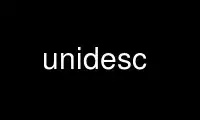
This is the command unidesc that can be run in the OnWorks free hosting provider using one of our multiple free online workstations such as Ubuntu Online, Fedora Online, Windows online emulator or MAC OS online emulator
PROGRAM:
NAME
unidesc - Describe the contents of a Unicode text file
SYNOPSIS
unidesc ([option flags]) (<file name>)
If no input file name is supplied, unidesc reads from the standard input.
DESCRIPTION
unidesc describes the content of a Unicode text file by reporting the character ranges to
which different portions of the text belong. The ranges reported include both official
Unicode ranges and the constructed language ranges within the Private Use Areas registered
with the Conscript Unicode Registry (http://www.evertype.com/standards/csur/). For each
range of characters, unidesc prints the character or byte offset of the beginning of the
range, the character or byte offset of the end of the range, and the name of the range.
Offsets start from 0.
Since the ASCII digits, punctuation, and whitespace characters are frequently used by
other writing systems, by default these characters are treated as neutral, that is, as not
belonging exclusively to any particular character range. These characters are treated as
belonging to the range of whatever characters precede them.
If the input begins with neutral characters, they are treated as belonging to the range of
whatever characters follow them. If the file consists entirely of neutral characters, the
range is identified as Neutral followed by Basic Latin in square brackets.
A magic number identifying the Unicode encoding is not part of the Unicode standard, so
pure Unicode files do not contain a magic number. However, informal conventions have
arisen for this purpose. If the command line flag -m is given, unidesc will attempt to
identify the Unicode subtype by examining the first few bytes of the input. If the input
is identified as one of the two acceptable types, UTF-8 or native order UTF-32, it will
then proceed to describe the contents of the input. Otherwise, it will report what it has
learned and exit. Note that if the file does contain a magic number, you must use the -m
flag. Without this flag unidesc assumes that the input consists of pure Unicode with the
character data beginning immediately. It will therefore be thrown off by the magic
number.
By default, input is expected to be UTF-8. Native order UTF-32 is also acceptable. UTF-32
may be specified via the command line flag -u or, if the command line flag -m is given,
via the magic number.
COMMAND LINE FLAGS
-b Give file offsets in bytes rather than characters.
-d Treat the ASCII digits as belonging exclusively to the Basic Latin range.
-h Print usage information.
-L List the Unicode ranges alphabetically.
-l List the Unicode ranges by codepoint.
-m Check the file's magic number to determine the Unicode subtype.
-p Treat ASCII punctuation as belonging exclusively to the Basic Latin range.
-r Instead of listing ranges as they are encountered, just list the ranges detected
after all input has been read.
-u Input is native order UTF-32.
-v Print version information.
-w Treat ASCII whitespace as belonging exclusively to the Basic Latin range.
Use unidesc online using onworks.net services
